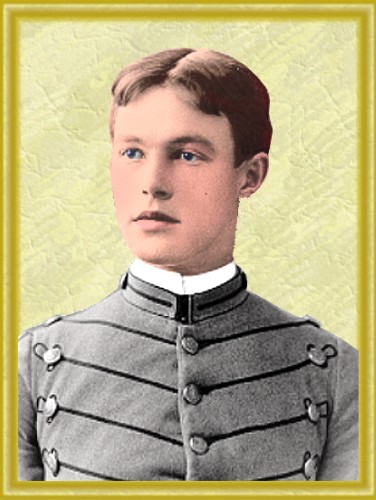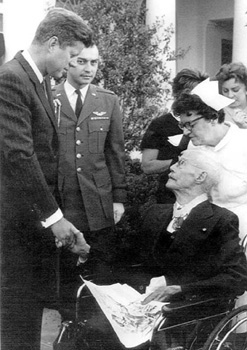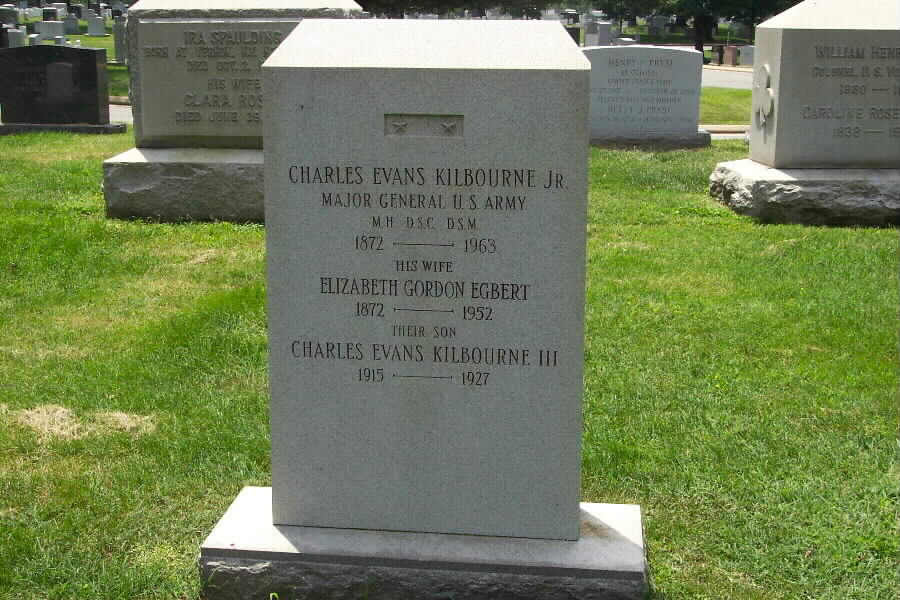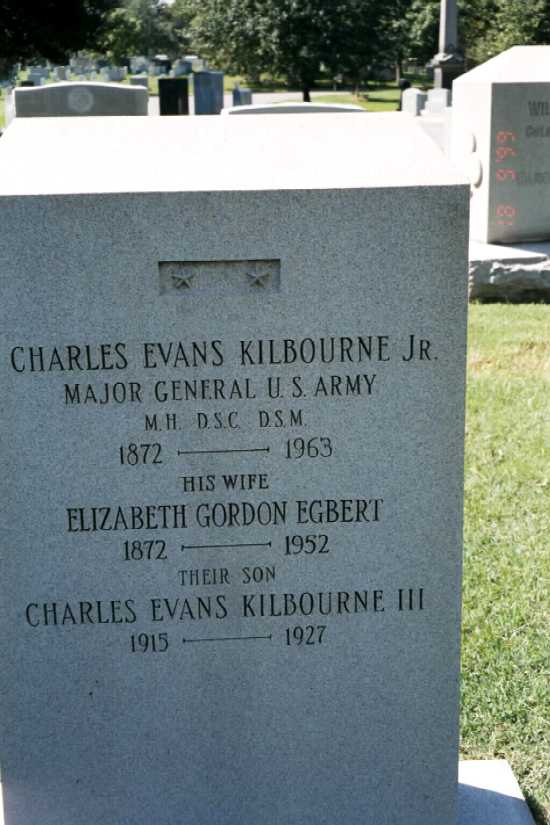Born at Fort Myer, Virginia, December 23, 1872, he graduated from the Virginia Military Institute and was a Honor Graduate of the Artillery School in 1903l; a graduate of the General Staff College in 1920. He was commissioned a Second Lieutenant, May 20, 1898 and promoted through the grades to Major General, July 9, 1935.
He served in the Spanish-American War in the campaign which captured Manila; he then served in the Philippine Insurrection, with operations in Cavite, Laguna and Bulucan Provinces; in the Boxer Rebellion in China and the relief of the Allied legations in Peking and then in operations in South Sulu.
He also was assigned to duty with the General Staff, 1911-13, 1915-19. He arrived in France on January 1, 1918 for service in World War I. He served on British and French fronts for a short period and then returned to Washington in March; he was back in France in May with the 89th Division, continuing with that unit until October 6, 1918. He commanded the 36th Heavy Artillery Brigade and the 3rd Infantry Brigade during the remainder of his service in France and Germany.
He was then head of the U.S. Mission inspecting the coastal defenses of Europe and Turkey. He returned to the U.S. in May 1919 and served on the faculty of the Army War College, 1920-24. He was Commandant of Boston Harbor, 1924-25; Executive Assistant to the Chief of Coast Artillery, 1925-28; commanded the 2nd Infantry Brigade, 1st Division, 1928-29; commanded the Coast Artillery District of Manila and Subig Bay, 1929-32; in the War Plans Division, Washington, 1932-34; commanded the VI Corps Area and 2nd Army, 1936.
He received the Medal of Honorfor “distinguished gallantry at Paca Bridge, Philippine Islands, February 5, 1899; the Distinguished Service Cross for “extraordinary heroism in action” near Thiacourt, France, September 12, 1918; the Distinguished Service Medal “for services in 89th Division and 36th Artillery Brigade”; Croix de Guerre (France) for “reconnaissances preparatory to assault on the St. Mihiel Salient,” and the Legion of Honor; Philippine and Victory Medals. He was the author of the Army Boy Scout Series (4 volumes), 1913-16; Baby Animal Books (10 volumes), 1913-17): editor, National Service Library (5 volumes), 1917.
He died on November 12, 1963 and was buried in Section 3 of Arlington National Cemetery.
His wife, Elizabeth Gordon Egbert Kilbourne (1872-1963), who he married on June 9, 1900, is buried with him.
Also in this site is his son, Charles Evans Kilbourne III (1915-1927).
KILBOURNE, CHARLES E JR S/O CHARLES E
- DATE OF DEATH: 01/03/1926
- DATE OF INTERMENT: Unknown
- BURIED AT: SECTION 3 SITE LOT 1705
ARLINGTON NATIONAL CEMETERY - SON OF CE KILBOURNE COL COAST ART
KILBOURNE, CHARLES EVANS
- M/GEN USA
- VETERAN SERVICE DATES: Unknown
- DATE OF BIRTH: 12/23/1872
- DATE OF DEATH: 11/12/1963
- DATE OF INTERMENT: 11/18/1963
- BURIED AT: SECTION 3 SITE 1705 RH
ARLINGTON NATIONAL CEMETERY
KILBOURNE, ELIZABETH G E W/O CHARLES E
- DATE OF BIRTH: 12/28/1872
- DATE OF DEATH: 06/02/1952
- DATE OF INTERMENT: 06/06/1952
- BURIED AT: SECTION 3 SITE 1705 LH
ARLINGTON NATIONAL CEMETERY - WIFE OF CE KILBOURNE – MAJ GEN USA RET
Courtesy of the U.S. Army Signal Corps:
Charles Evans Kilbourne Jr. was born on 23 December 1872 at Ft. Whipple (later renamed Ft. Myer in honor of the Signal Corp’s founder, Albert J. Myer). As the son of a Signal Corps Officer, Kilbourne spent much of his boyhood years at numerous Army installations. When he reached 15, he entered Ohio State University’s preparatory school but later left due to illness. In1891 he was admitted to the Virginia Military Institute and graduated in 1894 with a degree in Civil Engineering. Following graduation, Kilbourne moved west and worked as a surveyor in New Mexico and the Pacific Northwest. After serving for a time as an Indian school disciplinarian, he became an observer with the U.S. Weather Bureau until the war with Spain in 1898.
Kilbourne answered the call to arms and joined the Volunteer Signal School (VSC); an expansion of the regular Signal Corps assigned to provide tactical communications to the rapidly expanding Regular Army. In order to be accepted as an officer in the Volunteer Signal Corps, the applicant was to be adept in an electrical vocation or telegraphy. Kilbourne was one of the few commissioned VSC officers appointed for his leadership potential rather than for his technical expertise.
Kilbourne was assigned to the First Company, VSC, 2nd Lieutenant. He shipped out with Major General Arthur MacArthur’s expedition to the Philippine Islands where he participated in the campaign against Spanish forces climaxing in the seizure of Manila.
Following the end of hostilities with Spain, the Philippine Insurrection erupted on 4 February 1899. The following day 1st Lieutenant Kilbourne earned a place in history. “Within a range of 250 yards of the enemy and in the face of rapid fire (he) climbed a telegraph pole at the east end of {Paco Bridge} and in full view of the enemy coolly and carefully repaired a broken telegraph wire, thereby reestablishing telegraphic communication to the front.” For his gallantry and courage Kilbourne was awarded the Congressional Medal of Honor, the only Signal Officer to win it in the performance of a combat communications mission and the second Signal Corps officer to be awarded the honor.
Before leaving the Philippine Islands, Kilbourne applied for a commission in the Regular Army. Due to a physical disqualification, his request was denied. Subsequently he returned to San Francisco where he reapplied and was accepted as an infantry officer in the 14th Infantry Regiment.
In late 1899, he was ordered back to the Far East. Kilbourne participated in the Boxer Rebellion at Peking where he led his platoon in the assault that captured the Imperial City Gates. After suppression of the rebellion, his regiment returned to duty in the Philippine Islands. There Kilbourne performed his duties with the Provost Marshal’s office. It was during this tour that Kilbourne made an important career decision. In 1902 he requested and was granted a branch transfer to the Artillery Corps.
Transferred to Fort Monroe, Virginia to attend the Artillery School, he determined to learn all that he could about his new branch. Kilbourne was the honor graduate in his class and was assigned as the post district adjutant, a highly competitive and reputable position in his day. He served in this position for the next two years. Promoted to captain in 1905, Kilbourne assumed successive commands of coast artillery companies.
Kilbourne’s tenures in command were always characterized by demanding, tough training, and distinguished maintenance. Inspection reports commented on the “perfect conditions” of his coast artillery batteries and of his unit’s training, which resulted in setting new gunnery records and improved techniques for both range-finding and fire direction.
While commanding the 35th Company, Coast Artillery Corps, Kilbourne returned to the Philippine Islands. The company’s mission was the defense of Manila Bay. Kilbourne began the construction of an elaborate defensive fortification system on Corregidor Island. This was to have significant affects on the course of world events. The British credited it with saving Australia by delaying the Japanese advances at the beginning of World War II. (His efforts were finally completed in 1932 when as a brigadier general he commanded the entire harbor defenses of Manila.)
In 1909 Kilbourne left Corregidor to assume his duties as the Inspector, and later as Superintendent, of the Philippine Constabulary Bureau and School. His outstanding performance was not limited to the training environment. When Moro guerrillas threatened the local area, he undertook several tactical operations against them. In 1911 he was assigned to the War Department General Staff during which time he developed plans for the defense of Guantanamo Bay, Cuba. Serving in several staff positions for the following six years, Kilbourne established relationships with his superiors, peers, and subordinates based upon mutual respect and trust. While serving as the Chief of Staff, Southeastern Department, in Charleston, South Carolina, Major Kilbourne recognized the need for a regular army post in that section of the country. His foresight led to the establishment of Fort Jackson, South Carolina.
When the United States declared war on Germany in April, 1917, Major General Leonard Wood selected Kilbourne to be his Chief of the 89th Infantry Division. In preparing to move the division to France, Lieutenant Colonel Kilbourne made a pre-deployment, fact-finding trip to the front in France. While learning of the new demands of trench warfare, a mortar shell seriously wounded him. As a result, Kilbourne returned to Camp Funston, Kansas, where the 89th Infantry Division was training for the European Theater. Not deterred by his wounds and now a colonel, he led the advance party of the division to France and prepared the way for the 89th Infantry Division’s entry into combat. Once the division was in combat, the Chief of Staff set an example in leadership by “moving among the forward units, reorganizing them, and urging forward.” Kilbourne earned the Distinquished Service Cross for his efforts during the St. Mihiel offensive. In October, 1918, he was promoted to brigadier general and was the commanding general of both the 36th Artillery Brigade and later the 3rd Infantry Brigade of the 2nd Division. Major General John A. Lejune, commanding general of the 2nd Division, wrote that Kilbourne executed his duties in an “excellent, able, conscientious and painstaking” manner. Once again Kilbourne had proven his flexible approach to his duties and his ability to master his job in a short period of time. Kilbourne’s performance of duty in these last two assignments earned him the Distinquished Service Medal. He was the only soldier at that time to hold the nation’s three highest awards.
Upon his return to the United States and the reduction o the military’s size, Kilbourne reverted to his permanent rank of major in the Regular Army. Assigned as an instructor and student to the Army War College in Washington, D.C., he graduated with honors and later became a course director at the college. By 1928 he was promoted to brigadier general in the Regular Army and served another tour in the Philippines. He returned to Fort Sam Houston in 1936. He subsequently served as the superintendent of the Virginia Military Institute for nine years until he retired from that post for health reasons. Kilbourne died in 1963.
KILBOURNE, CHARLES E.
Rank and organization: First Lieutenant, U.S. Volunteer Signal Corps. Place and date: At Paco Bridge, Philippine Islands, 5 February 1899. Entered service at. Portland. Oregon. Birth: Fort Myer, Virginia. Date of issue: 6 May 1905.
Citation
Within a range of 250 yards of the enemy and in the face of a rapid fire climbed a telegraph pole at the east end of the bridge and in full view of the enemy coolly and carefully repaired a broken telegraph wire, thereby reestablishing telegraphic communication to the front.
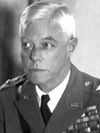
President John F. Kennedy greets Kilbourne in early 1963 at a lawn party
hosted by the White House for Medal of Honor recipients. Kilbourne
was the oldest Medal of Honor recipient present, according to Kilbourne
family historian Jim Kilburn. A few months after this photograph was taken,
Kilbourne died and Kennedy was assassinated in Dallas.
Michael Robert Patterson was born in Arlington and is the son of a former officer of the US Army. So it was no wonder that sooner or later his interests drew him to American history and especially to American military history. Many of his articles can be found on renowned portals like the New York Times, Washingtonpost or Wikipedia.
Reviewed by: Michael Howard

